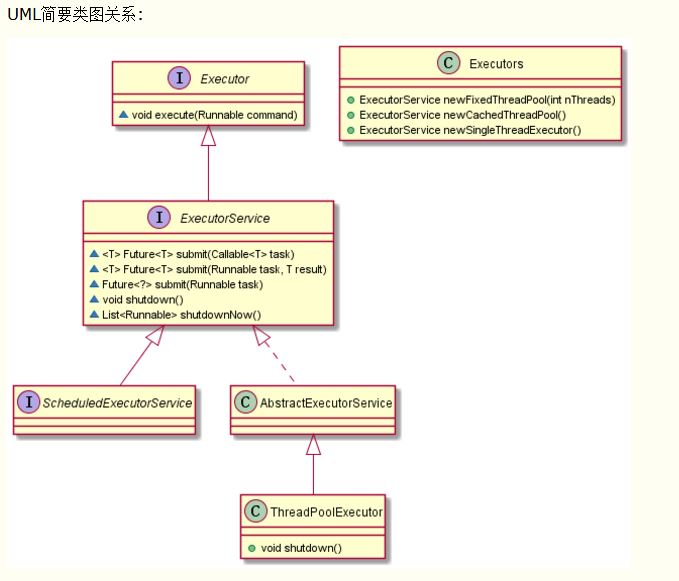Executor、ExecutorService、Executors三者的区别:

层次关系:
public interface ExecutorService extends Executor {} public abstract class AbstractExecutorService implements ExecutorService {} public interface ScheduledExecutorService extends ExecutorService {} public class ThreadPoolExecutor extends AbstractExecutorService {} public class ScheduledThreadPoolExecutor extends ThreadPoolExecutor implements ScheduledExecutorService {}
区别:
1.ExecutorService 接口继承了Executor 接口,是Executor 的子接口。
2.Executor接口中定义了execute()方法,用来接收一个Runnable接口的对象,
而ExecutorService接口中定义的submit()方法可以接收Runnable和Callable接口对象。
3.Executor接口中execute()方法不返回任何结果,而ExecutorService接口中submit()方法可以通过一个 Future 对象返回运算结果。
4.Executor和ExecutorService除了允许客户端提交一个任务,ExecutorService 还提供用来控制线程池的方法。
比如:调用
shutDown() 方法终止线程池。 5.Executors 类提供工厂方法用来创建不同类型的线程池。比如:
Executors.newSingleThreadExecutor() 创建一个只有一个线程的线程池,
Executors.newFixedThreadPool(int numOfThreads)来创建固定线程数的线程池,
Executors.newCachedThreadPool()创建一个可缓存线程池,如果线程池长度超过处理需要,可灵活回收空闲线程,若无可回收,则新建线程。
Executors.newScheduledThreadPool(int corePoolSize) 创建一个线程池,它可安排在给定延迟后运行命令或者定期地执行。
下面是部分源码:
public interface Executor { void execute(Runnable command); }
public interface ExecutorService extends Executor { void shutdown(); List<Runnable> shutdownNow(); boolean isShutdown(); boolean isTerminated(); boolean awaitTermination(long timeout, TimeUnit unit) throws InterruptedException; <T> Future<T> submit(Callable<T> task); <T> Future<T> submit(Runnable task, T result); Future<?> submit(Runnable task); <T> List<Future<T>> invokeAll(Collection<? extends Callable<T>> tasks) throws InterruptedException; <T> List<Future<T>> invokeAll(Collection<? extends Callable<T>> tasks, throws InterruptedException; <T> T invokeAny(Collection<? extends Callable<T>> tasks) throws InterruptedException, ExecutionException; <T> T invokeAny(Collection<? extends Callable<T>> tasks, long timeout, TimeUnit unit) throws InterruptedException,ExecutionException, TimeoutException; }
public class Executors { /** Cannot instantiate. */ private Executors() {} public static ExecutorService newFixedThreadPool(int nThreads) { return new ThreadPoolExecutor(nThreads, nThreads, 0L, TimeUnit.MILLISECONDS, new LinkedBlockingQueue<Runnable>()); } public static ExecutorService newWorkStealingPool(int parallelism) { return new ForkJoinPool (parallelism,ForkJoinPool.defaultForkJoinWorkerThreadFactory,null, true); } public static ExecutorService newWorkStealingPool() { return new ForkJoinPool (Runtime.getRuntime().availableProcessors(), ForkJoinPool.defaultForkJoinWorkerThreadFactory,null, true); } public static ExecutorService newFixedThreadPool(int nThreads, ThreadFactory threadFactory) { return new ThreadPoolExecutor(nThreads, nThreads, 0L, TimeUnit.MILLISECONDS, new LinkedBlockingQueue<Runnable>(),threadFactory); } public static ExecutorService newSingleThreadExecutor() { return new FinalizableDelegatedExecutorService(new ThreadPoolExecutor(1, 1,0L, TimeUnit.MILLISECONDS, new LinkedBlockingQueue<Runnable>())); } public static ExecutorService newSingleThreadExecutor(ThreadFactory threadFactory) { return new FinalizableDelegatedExecutorService(new ThreadPoolExecutor(1, 1, 0L, TimeUnit.MILLISECONDS, new LinkedBlockingQueue<Runnable>(), threadFactory)); } public static ExecutorService newCachedThreadPool() { return new ThreadPoolExecutor(0, Integer.MAX_VALUE, 60L, TimeUnit.SECONDS,new SynchronousQueue<Runnable>()); } public static ExecutorService newCachedThreadPool(ThreadFactory threadFactory) { return new ThreadPoolExecutor(0, Integer.MAX_VALUE,60L, TimeUnit.SECONDS, new SynchronousQueue<Runnable>(),threadFactory); } public static ScheduledExecutorService newSingleThreadScheduledExecutor() { return new DelegatedScheduledExecutorService (new ScheduledThreadPoolExecutor(1)); } public static ScheduledExecutorService newSingleThreadScheduledExecutor(ThreadFactory threadFactory) { return new DelegatedScheduledExecutorService (new ScheduledThreadPoolExecutor(1, threadFactory)); } public static ScheduledExecutorService newScheduledThreadPool(int corePoolSize) { return new ScheduledThreadPoolExecutor(corePoolSize); } public static ScheduledExecutorService newScheduledThreadPool(int corePoolSize, ThreadFactory threadFactory) { return new ScheduledThreadPoolExecutor(corePoolSize, threadFactory); } public static ExecutorService unconfigurableExecutorService(ExecutorService executor) { if (executor == null) throw new NullPointerException(); return new DelegatedExecutorService(executor); } public static ScheduledExecutorService unconfigurableScheduledExecutorService(ScheduledExecutorService executor) { if (executor == null) throw new NullPointerException(); return new DelegatedScheduledExecutorService(executor); } public static ThreadFactory defaultThreadFactory() { return new DefaultThreadFactory(); } public static ThreadFactory privilegedThreadFactory() { return new PrivilegedThreadFactory(); } public static <T> Callable<T> callable(Runnable task, T result) { if (task == null) throw new NullPointerException(); return new RunnableAdapter<T>(task, result); } public static Callable<Object> callable(Runnable task) { if (task == null) throw new NullPointerException(); return new RunnableAdapter<Object>(task, null); } public static Callable<Object> callable(final PrivilegedAction<?> action) { if (action == null) throw new NullPointerException(); return new Callable<Object>() { public Object call() { return action.run(); }}; } public static Callable<Object> callable(final PrivilegedExceptionAction<?> action) { if (action == null) throw new NullPointerException(); return new Callable<Object>() { public Object call() throws Exception { return action.run(); }}; } public static <T> Callable<T> privilegedCallable(Callable<T> callable) { if (callable == null) throw new NullPointerException(); return new PrivilegedCallable<T>(callable); } public static <T> Callable<T> privilegedCallableUsingCurrentClassLoader(Callable<T> callable) { if (callable == null) throw new NullPointerException(); return new PrivilegedCallableUsingCurrentClassLoader<T>(callable); } }
/** 表示异步计算的结果。 */ public interface Future<V> { /** * 试图取消对此任务的执行 */ boolean cancel(boolean mayInterruptIfRunning); /** *如果在任务正常完成前将其取消,则返回 true。 */ boolean isCancelled(); /** * 如果任务已完成,则返回 true。 */ boolean isDone(); /** *如有必要,等待计算完成,然后获取其结果。 */ V get() throws InterruptedException, ExecutionException; /** *如有必要,最多等待为使计算完成所给定的时间之后,获取其结果(如果结果可用)。 */ V get(long timeout, TimeUnit unit) throws InterruptedException, ExecutionException, TimeoutException; }